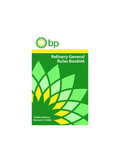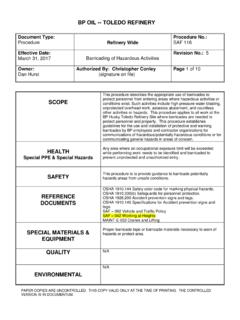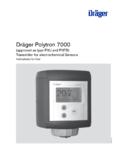Transcription of BP OIL -- TOLEDO REFINERY
1 BP OIL -- TOLEDO REFINERY PAPER COPIES ARE UNCONTROLLED. THIS COPY VALID ONLY AT THE TIME OF PRINTING. THE CONTROL VERSION OF THIS DOCUMENT IS CONTROLLED IN DOCUMENTUM. Document Type: Procedure Area: REFINERY Wide Procedure No.: SAF 087 Effective Date: September 18, 2014 Hydrogen Sulfide (H2S) Rev. No.: 5 Owner: Matt Grimes Auth. By: D. C. Durnwald (signature on file) Page 1 of 7 SCOPE This document serves as an overview of the REFINERY H2S practices and procedures used to protect people from H2S exposure HEALTH Special PPE & Special Hazards When concentrations of H2S are not known, cannot be assessed, or are likely to change, supplied breathing air respirators shall be used. SAFETY Standard REFINERY PPE Safe work practices when opening valves or other equipment.
2 REFERENCE DOCUMENTS Process Safety Minimum Expectation No. Hydrogen Sulfide Processing and Handling Operating manuals for the gas tester being used (such as Toxi-Pro/Toxi-Ltd Personal H2S Meter and MSA Five Star Passport 4-gas tester, Solaris 4-gas tester). SAF 014 Donning Self-Contained Breathing Apparatus SPECIAL MATERIALS & EQUIPMENT Direct reading, gas testing equipment Supplied air respirators Personal H2S meters QUALITY Periodic employee audits to insure knowledge of H2S hazards and protection systems. Audits of H2S training records. ENVIRONMENTAL N/A Procedure No. SAF 087 Rev. No. 5 Page 2 of 7 PAPER COPIES ARE UNCONTROLLED. THIS COPY VALID ONLY AT THE TIME OF PRINTING. THE CONTROL VERSION OF THIS DOCUMENT IS CONTROLLED IN DOCUMENTUM.
3 OVERVIEW Hydrogen sulfide (H2S) is a colorless or light yellow-colored gas with a powerful nauseating smell of rotten eggs. The odor is a poor warning property because hydrogen sulfide exposure quickly deadens the sense of smell. The gas is heavier than air and may collect in low areas such as sewers, pits, tunnels or gullies. High airborne levels of hydrogen sulfide (between and percent of gas by volume in the air) may catch fire if there is a source of ignition. If the gas is burned, toxic products such as sulfur dioxide will be formed. TOLEDO REFINERY processes sulfur-containing crudes. This will result in H2S production in nearly all REFINERY units. Closed operating systems keep H2S inside piping and vessels, thereby minimizing the risk of exposure.
4 Routine maintenance and/or operating tasks may require line-breaking rendering the previously closed system to become open. For this reason, special equipment design, and work procedures and practices are in place to minimize risk of exposure to REFINERY personnel and the community. H2S Exposure It is crucial that all employees recognize and understand the human body s response to H2S gas. Refer to Table 1 for the summary of physiological effects from changing levels of H2S concentrations. Workplace atmospheric H2S concentrations must be maintained at or below regulatory limits (Refer to Table 2). The Control of Work process and Task Risk Assessments are used to help risk assess and document the H2S hazards. Personal H2S meters are required to be worn in all non-green zone areas of the REFINERY .
5 See SAF 026 (Personal Protective Equipment Policy). The operator s knowledge of operating conditions of the unit will help guide the decision to require additional protective equipment. Fixed H2S gas detection systems are strategically stationed in plant areas that have high H2S concentration streams and/or in buildings that may contain H2S if there is a vapor release. Area Location North Poly Plant, Unsat Gas Plant, Cat Poly Analyzer building, Nerve Center, Sat 3, Sat 5, North POD West SRU 1,2,3; Vent areas of Tanks 294 and 295, Coker 2, Coker 3; Analyzer buildings in SRU s and Coker 3, Sat 5, Sat 6, West POD South ADHT, BGOT; DHT Compressor Deck, Crude 1, West Boiler Analyzer building, Sat 2 and Sat 4 buildings, Analyzer building in the ESP, H2 Plant.
6 East Analyzer buildings in: Iso 2, Alky 3, Ref 2 Areas, Alky 1 Sat bldg, Alky 2 Sat bldg, Sat 7 bldg, East POD OM&S Blender Sat bldg, Fluor Warehouse, WWTU Belt Press, Trailer City, LPG POD, Truck 5 POD Most process analyzer buildings have external alarm red lights to warn of an elevated H2S condition. Procedure No. SAF 087 Rev. No. 5 Page 3 of 7 PAPER COPIES ARE UNCONTROLLED. THIS COPY VALID ONLY AT THE TIME OF PRINTING. THE CONTROL VERSION OF THIS DOCUMENT IS CONTROLLED IN DOCUMENTUM. In the event of an emergency, personnel will shelter-in-place and shut down the intake of the building ventilation system. Process PODs have the ability to test the room atmosphere with direct reading gas testing equipment. This may include the MSA Passport, Draeger CMS or Gas Tec with detector tubes, and personal H2S meters.
7 Essential personnel, involved in the emergency, have supplied breathing air available inside each POD. Safety Equipment Supplied breathing air packs are checked for operability and accessibility at least monthly by Asset group. Fixed, stationary, H2S detectors are checked and calibrated monthly by an analyzer specialist. These are located in a variety of areas in the REFINERY . See section Personal H2S meters must be bump tested once within each 24 hours time of use and calibrated every 30 days. It is the responsibility of the personal meter user to insure this is done. A flashing red light will illuminate on the personal H2S meter when it is >24 hours since the meter s last bump test. An additional bump test shall be performed following an event that alarms the meter.
8 Signs depicting Caution Hydrogen Sulfide may be present are posted in process areas where H2S could exceed occupational exposure limits. Direct reading, gas detection equipment is available at all POD areas in order to quickly, and accurately assess small H2S leaks. A traction report will be completed by the supervisor of the BP employee or the BP contact if it is a contractor employee involved for any event that causes a personal H2S or fixed H2S meter to alarm. The max, or peak reading will be entered into the traction report. The Asset group checks fire monitors monthly. Water fogging is a useful and recommended method to minimize a H2S gas release to other units or off-site. Training All personnel (employees and contractors) who enter areas where they could be exposed to H2S streams must receive initial training on the hazards of hydrogen sulfide.
9 BP employees will receive this in the annual mandatory/regulatory training. Contractor employees will have this training as part of their initial and annual contractor safety training. This training will include at least the following: Chemical characteristics and properties of H2S, occupational exposure limits and the body s physiological response to H2S. Methods to detect H2S and the types of methods of alterting and warning systems in the plant. Procedure No. SAF 087 Rev. No. 5 Page 4 of 7 PAPER COPIES ARE UNCONTROLLED. THIS COPY VALID ONLY AT THE TIME OF PRINTING. THE CONTROL VERSION OF THIS DOCUMENT IS CONTROLLED IN DOCUMENTUM. How to respond in the case of a personal H2S alarm. The hazards of pyrophoric scale. Emergency procedures and escape routes.
10 Lessons learned involving H2S incidents. A computer-based training module is used to insure competency of understanding H2S hazards. BP employees receive this training module followed with an electronic test. Contractor employees will receive H2S education and answer H2S specific questions on the contractor training written test. Normal Operating Practices, Permits and Procedures The operator must have knowledge of the hydrogen sulfide-containing equipment and streams in the work area in order to adequately assess and communicate potential H2S hazards. Potential hydrogen sulfide exposure shall be considered as part of the risk assessment process and documented on the Permit to Work (PTW). Hydrogen sulfide stream samples need to have caution labels and/or signs affixed to the sample container.




